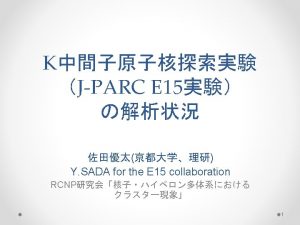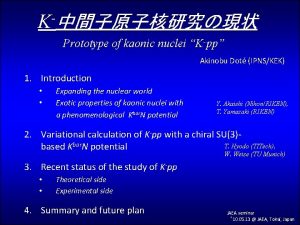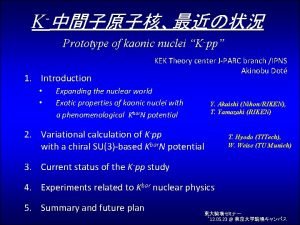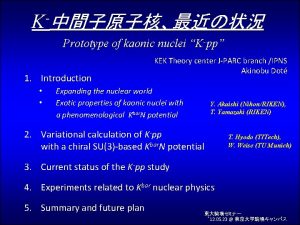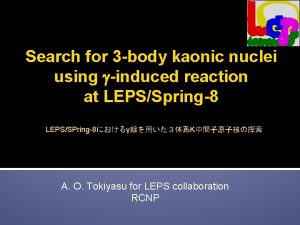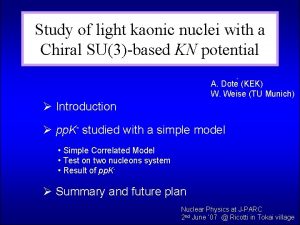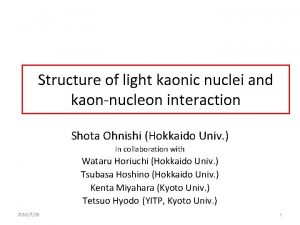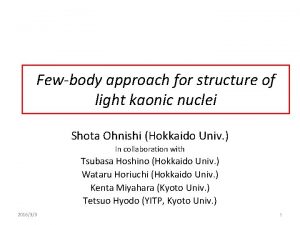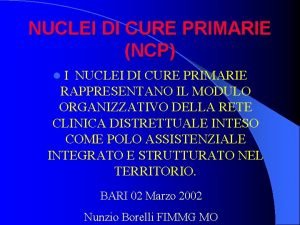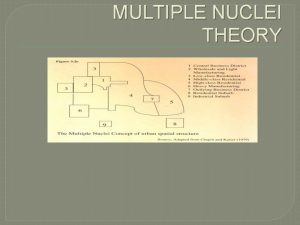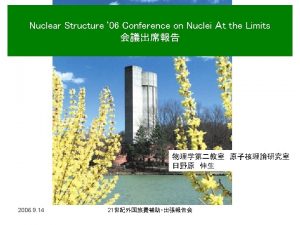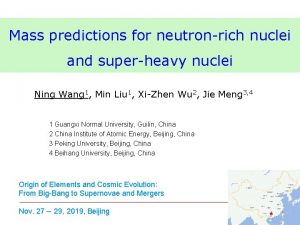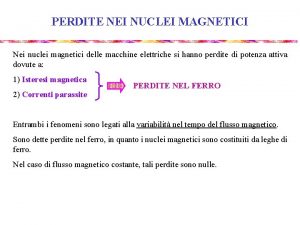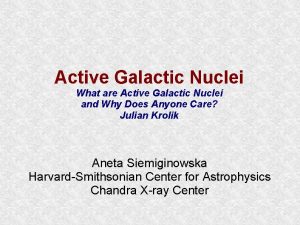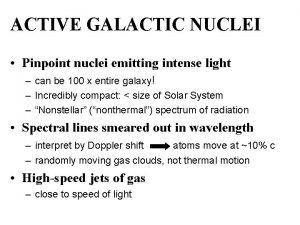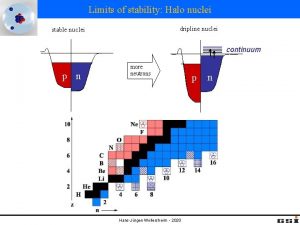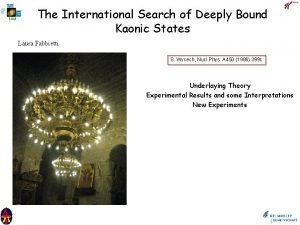Status of the Seatch for Kaonic Nuclei E









































![K-induced vs p-induced • p- stopped [1] D. Gotta, et al. , PRC 51. K-induced vs p-induced • p- stopped [1] D. Gotta, et al. , PRC 51.](https://slidetodoc.com/presentation_image_h2/4fc0dae6d8f3edac75c328b68d9d6072/image-42.jpg)
- Slides: 42

Status of the Seatch for Kaonic Nuclei (E 15) at J-PARC RIKEN H. Outa for E 15 collabolation ✔ Kaonic nuclei ✔ Present status of the E 15 experiment at J-PARC Search for the K-pp bound state in the 3 He(in-flight K-, n/p) reaction - 3 He(in-flight K-, n) spectrum Hashimoto ar. Xiv: [nucl-ex]1408. 5637 submitted to PLB - Λp+n(missing) channel analysis Sada (- 3 He(in-flight K-, p) spectrum Tokuda )

The J-PARC E 15 Collaboration 2

Kaonic Nuclei Kaonic nucleus is a bound state of nucleus and anti-kaon (Kbar. NN, Kbar. NNN, Kbar. NN, . . . ) Density [1/fm 3] Y. Akaishi & T. Yamazaki, PLB 535, 70(2002). T. Yamazaki, A. Dote, Y. Akiaishi, PLB 587, 167 (2004). 3



E 15: “K -pp” search via 3 He(K -, n) @p K=1 Ge. V/c without 2 NA background Formation & Decay Y decay can be rejected for efficient “pp. K” formation (quasi-free KN) 6

Experimental Setup m 15 7

E 15 1 st Stage Physics-Run • Production run of ~1% of the approved proposal was successfully performed in 2013. • All detector systems worked well as designed. March, 2013 Primary-beam intensity Secondary-kaon intensity Duration Kaons on target (w/ tgt selection) 14. 5 k. W (18 Tppp, 6 s) 80 k/spill 30 h 1. 1 x 109 24 k. W (30 Tppp, 6 s) 140 k/spill 88 h 5. 3 x 109 (Run#47) May, 2013 (Run#49 c) * production target: Au 50% loss, spill length: 2 s, spill duty factor: ~45%, K/pi ratio: ~1/2 * ~70% of beam kaons hit the fiducial volume of 3 He target 8

Analysis Status of E 15 -1 st 9

3 He (K-, n) semi-inclusive spectrum ( Hashimoto )


3 He (K-, n) semi-inclusive spectrum

Tail component in the bound region is NOT due to the detector resolution !!



Background Evaluation quasi-elastic KN (Phys. BG) (Exp. BG) evaluated using empty-target data (Exp. BG) 1/β distribution for ɤ/n g n 16

Spectrum below the Threshold T. Hashimoto et al. , ar. Xiv: 1408. 5637, submitted to PLB excess FINUDA/ DISTO ✔ No significant structure in the deep-binding region 17 ✔ Excess (tail) exist just below K -pp threshold

E 15 and Other Experiments U. L. evaluation with: K-pp Lp 100% (isotropic) K-pp shape = Breit-Wigner PRL 94(2005)212303 l E 15(K -+3 He): (UL) 0. 5 -5% of QF PRL 104(2010)132502 ar. Xiv: 1411. 6708 l FINUDA(stopped K -): ~0. 1% of stopped Kl DISTO(p+p): larger than L* @ 2. 85 Ge. V l LEPS(g+d) (UL) 1. 5 -26% of g. N K+p 18 -Y

Comparison between E 15 and Calc. semi-inclusive DATA (BG subtracted) Koite, Harada, PRC 80(2009)055208 DATA (BG subtracted) inclusive integrated CS: ~mb/sr • CS is roughly consistent with KH • Loosely-bound K-pp state ? ? ? semi-inclusive integrated CS: ~0. 1 mb/sr Yamagata-Sekihara, et al. , PRC 80(2009)045204 p. SN measurement 19 is an important key

kinematically complete, w/ 4 -momenta conservation Decay Channel Exclusive 3 He(K -, Λp)n • revised analysis! pπ- (=Λ) pair defined by probability to improve the Λ definition 20

3 He(K -, ppπ-)X CDS = 3 He(K -, Λp)nmis. events Λ pp- reconstruction p missing n preliminary Λ 1 Ge. V/c K- beam p π− IM(Λp) preliminary MM of 3 He(K -, Λp)X preliminary 21


3 He(K -, Λp)n Events Dalitz plot in CM preliminary counts kinematically complete, w/ 4 -momenta conservation est l tr pa e lin • • est tr n at rest line Λa ine preliminary structure found near K -pp threshold 2 NA reaction K -+3 He → Λ+p+n s seem to be very weak 3 NA reaction K -+3 He → Λ+p+n exist, but weak as well 2 NA Λ(1405) production excluded; Λ(1405)+n+p S (2 NA) 23

counts Angular distribution of the excess preliminary — smaller q. X = 0. 6 Ge. V/c q. X = 0. 8 Ge. V/c Forward neutron preliminary 3 NA-like events distribute widely in formation angle as expected = q. X = 1. 0 Ge. V/c Low momentum transfer preferred — larger q. X 24

Kinematically-complete 3 He(K -, Λpn) preliminary ~10 events K-+p+p threshold Dalitz plot in CM Count per 0. 005 Ge. V/ca redundant w/ 4 -momenta conservation preliminary • Formation neutron selectively (no effect from Λp / Σ 0 p) • 3 NA largely suppressed (consistent with n mis. events) • more data awaited Σ 0 p 25

E 15 1 st Formation vs Decay Formation channel semi-inclusive K- + 3 He → n + X (θn=0) – excess below threshold background-free – contribution from Λ(1405)n + p S (2 NA) may exist 3 He(K-, n)X θn=0 quasi-elastic KN y r a in ive im rch l e a r P n o semi-inclusive Y-decay free excess exclusive Decay channel exclusive K- + 3 He → Λ + p + nmis. – excess exist near threshold – cannot be Λ(1405)n + p S (2 NA), because F. S. = Λ p n – contamination Σ 0 < 20% +p y r K- + 3 He → Λ 3 He(K-, Λp)n a nσ + nmis. DISTO/FINUDA Λp invariant mass il m i tot ~ 200 μb e r P 26

Semi-Inclusive 3 He(K -, n/p)X M. M. spectrum E 548@KEK (K-, n) PTP 118(2007)181 Re(V) = ~190 Me. V preliminary (K , p) • 3 He(K -, p) Re(V) = ~160 Me. V spectrum looks similar to (K -, n) 27

Summary – Inclusive (K-, n)X: submitted to. PLB ✔ upper limit for deeply bound region ✔ excess in loosely bound region – Exclusive (K- , Λp) n: will be finalizedsoon ✔ Dalitz plot suggest two-components - Inclusive (K-, p)X : analysis undergoing 28

Thank you for attention!

Backup 30



Efficiency = 23± 4% MM resolution ~ 10 Me. V

3 He(K -, n): hint in exclusive 3 He(K -, p+p-pn)n Blue: in CDS / Red: in NC K- +3 He S+- + p-+ + p + n S+- n + p+or K- +3 He S+- + p-+ + p + n S+- n + p+- E 15 1 st preliminary • Very low statistics, but some structure in the binding region? 34

3 He(K -, n): hints in L/pp-tagging E 15 1 st preliminary • tagging method would address the origin of the sub-threshold excess 35

p(K-, K 0 S)nforward yield (n in NC acc. ) • Nt = 5. 8*1023 /cm 2 • • • – ρ = 70. 85*10 -3 g/cm 3 – l = 13. 67 cm NK = 1. 1*10 5 /spill/9 s [run#49 c * 0. 8] -27 2 σ = 3. 92*10 cm (= 7. 84 mb * 0. 5) [past measurement] -3 ε (decay*(CDS*NC acc)) = 5. 4*10 [Monte-Carlo] ε (beam ana) = 0. 65 ε (loss) = 0. 97 ε (fiducial selection) = 0. 70 [Run#49 c condition] ε (trig*DAQ) = 0. 80 expected error: ε (analysis) = 0. 90 K 0 S in CDS w/ NC acc. ~ 3400 K*CDH 2 pre-scale = 1/5 K 0 & n detection ~ 800 [~ run#49 c / 0. 8] S NC eff. ~ 0. 23 +/- 0. 007(stat. ) 3. 4 x 10 3 per 4 days (w/o NC eff. )

ε (NC) = 23+/-4% 37

d(K−, n)Λ(1405) yield E 31 status report, May, 2014 1. 1 x 10 5 [Run#49 c condition] 20 days [prediction]

Typical Trigger Condition in 1 Ge. V/c K - + 3 He @ Run#49 c [24 k. W (30 Tppp)] Doctor thesis, T. Hashimoto, The University of Tokyo, 2014. 3 39

Semi-Inclusive Spectrum Quasi Elastic K- + 3 He K- + n + ps dσ/dΩθ =0 deg ~ 6 mb/sr and Charge-Exchange K- + 3 He K 0 + n + ds K 0 π + + π dσ/dΩθ =0 deg ~ 11 mb/sr 40 The tail structure is not due to “the detector resolution”

Dalitz plot preliminary 2 NA: e. g. K-3 He Lpns 2 NA+2 step: e. g. K-3 He S 0 pns, S 0 ns Ln 2 NA+2 step: e. g. K-3 He Lpns, pns pn 2 NA+2 step: e. g. K-3 He S 0 nps, S 0 ps Lp K-pp form. : K-3 He (K-pp)n, K-pp Lp 41
![Kinduced vs pinduced p stopped 1 D Gotta et al PRC 51 K-induced vs p-induced • p- stopped [1] D. Gotta, et al. , PRC 51.](https://slidetodoc.com/presentation_image_h2/4fc0dae6d8f3edac75c328b68d9d6072/image-42.jpg)
K-induced vs p-induced • p- stopped [1] D. Gotta, et al. , PRC 51. 496 (1995) [2] P. Weber et al. , NPA 501 765 (1989) [3] G. Backenstoss et al. , PRL 55. 2782 (1985) – 2 nucleon absorption &FSI (50%/p stopped) are clearly seen – 3 nucleon absorption <3% /p stopped • p- in-flight [2], [3] – 2 nucleon absorption 0. 85 ± 0. 17 mb (266 Me. V/c) – 3 nucleon absorption 3. 7 ± 0. 6 mb(220 Me. V/c) – 3 NA/2 NA ~ 4 in-flight K preliminary stopped p Data suggests that 3 NA reactions are dominant? 42
 Sju principer för tillitsbaserad styrning
Sju principer för tillitsbaserad styrning Tack för att ni lyssnade bild
Tack för att ni lyssnade bild Expektans
Expektans Kanaans land
Kanaans land Ro i rom pax
Ro i rom pax Modell för handledningsprocess
Modell för handledningsprocess Informationskartläggning
Informationskartläggning Magnetsjukhus
Magnetsjukhus Matematisk modellering eksempel
Matematisk modellering eksempel Cks
Cks Shaktismen
Shaktismen Kassaregister ideell förening
Kassaregister ideell förening Inköpsprocessen steg för steg
Inköpsprocessen steg för steg Lyckans minut erik lindorm analys
Lyckans minut erik lindorm analys Strategi för svensk viltförvaltning
Strategi för svensk viltförvaltning Beräkna standardavvikelse
Beräkna standardavvikelse Rutin för avvikelsehantering
Rutin för avvikelsehantering Datorkunskap för nybörjare
Datorkunskap för nybörjare Tack för att ni har lyssnat
Tack för att ni har lyssnat Treserva lathund
Treserva lathund Läkarutlåtande för livränta
Läkarutlåtande för livränta Vad står k.r.å.k.a.n för
Vad står k.r.å.k.a.n för Påbyggnader för flakfordon
Påbyggnader för flakfordon Tack för att ni lyssnade
Tack för att ni lyssnade Tobinskatten för och nackdelar
Tobinskatten för och nackdelar Egg för emanuel
Egg för emanuel Tack för att ni har lyssnat
Tack för att ni har lyssnat Nyckelkompetenser för livslångt lärande
Nyckelkompetenser för livslångt lärande Verifikationsplan
Verifikationsplan Var finns arvsanlagen
Var finns arvsanlagen Tidbok
Tidbok Rbk-mätning
Rbk-mätning Presentera för publik crossboss
Presentera för publik crossboss Myndigheten för delaktighet
Myndigheten för delaktighet Kontinuitetshantering
Kontinuitetshantering Var 1721 för stormaktssverige
Var 1721 för stormaktssverige Tack för att ni har lyssnat
Tack för att ni har lyssnat Tack för att ni lyssnade bild
Tack för att ni lyssnade bild Vad är referatmarkeringar
Vad är referatmarkeringar Epiteltyper
Epiteltyper Karttecken färger
Karttecken färger Varför kallas perioden 1918-1939 för mellankrigstiden?
Varför kallas perioden 1918-1939 för mellankrigstiden? Lufttryck formel
Lufttryck formel











































